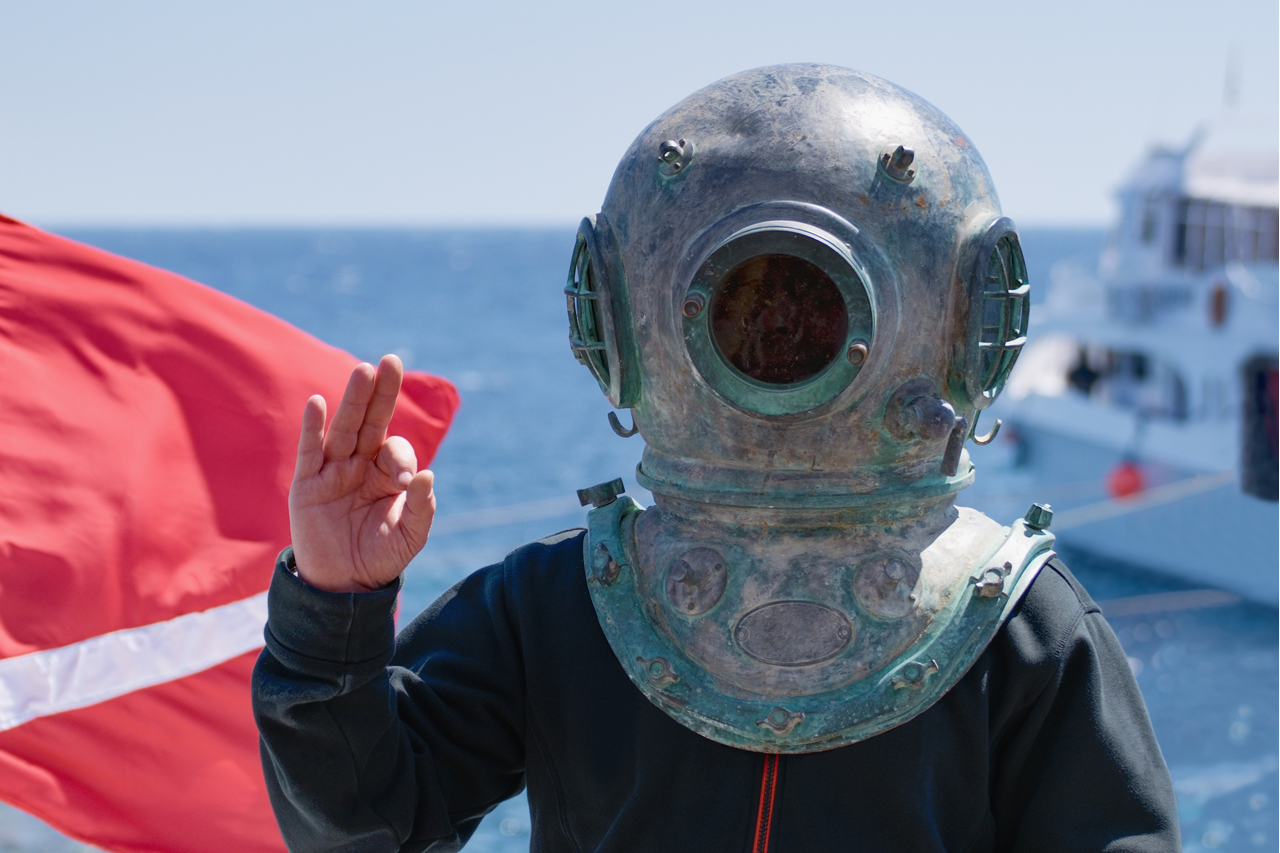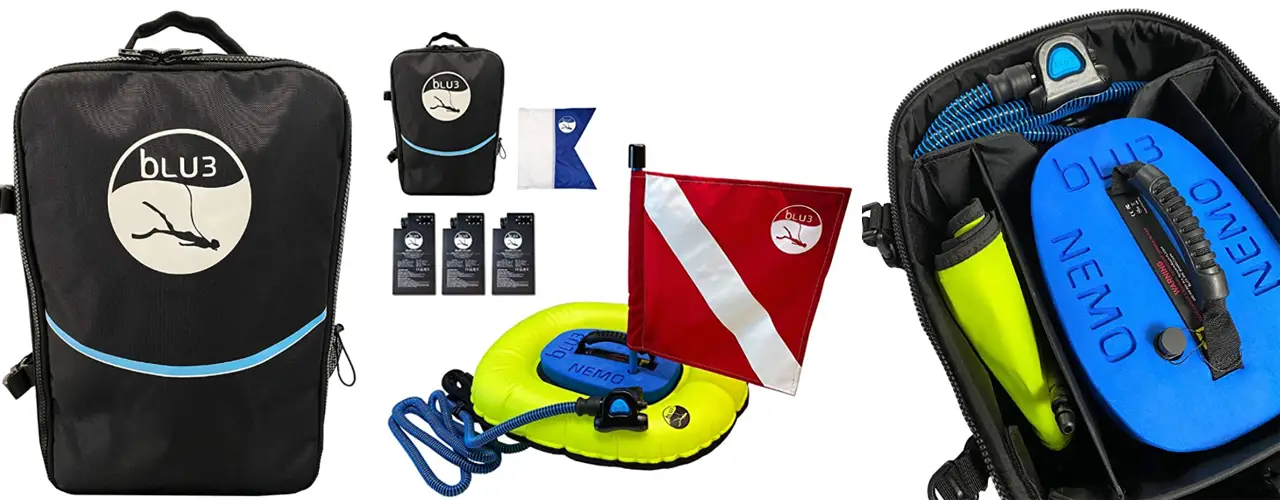
In comparison to most of the other gear I cover on my website, let me start by saying that this is one of the few gadgets I don’t own myself. I usually talk about gear that I actually own, because that’s how I know if I actually like a product or not.
Just to be totally transparent, I’m doing this review without personal experience. I thought you should know. However, the thing is, this seems like such a cool gadget to me. I couldn’t resist to do some research and share it with you guys and girls.
The Tankless Diving System by BLU3
The video below explains and shows you the most important details in just over 1 minute. Probably more fun to watch that, but let me summarize the basics if you prefer to read.
In this article I’ll cover the “Nemo” version which allows you to dive up to 10 feet for about an hour. In my opinion 10 feet is more than enough and puts less pressure on your ears. You still need to equalize, but going further down in my opinion is not really the best idea for beginners or recreational snorkelers. I briefly covered equalizing in my review about snorkeling with earplugs, but more in depth information can be found on this website.

Nemo (For Beginner Snorkelers – Up To 10 Feet)
In my opinion, the Nemo version is more than enough for many snorkelers. I usually snorkel in shallow areas anyway, so reaching a depth of 10 feet is more than enough for me. Like I said, consider equalizing and especially think about your safety. I would personally never dive down deeper than 10 feet without a Padi license and proper scuba gear. But of course, that’s just me. I think it’s really great that they have a training program, which I’ll talk about later.
Nemo lets you explore the underwater world for up to 90 minutes. The battery will run out eventually since the system needs to pump compressed air towards your mouthpiece. I read that some people use it for about 60 minutes, maybe because they require more energy and breathing than others. But hey, 60 minutes is still awesome! You also get the option to add additional battery packs to your order. If you just can’t get enough, grab 1 or 2 more and recharge them as soon as the battery is done.
Nomad (For Experienced Snorkelers – Up To 30 Feet)
As I mentioned, this is for experienced snorkelers who know how to swim and who should have enough experience in diving down. We’re not all freedivers in the end. I totally understand how cool it must be to observe that brain coral at the bottom of that 30 feet deep ocean. And don’t get me wrong, I think this is an amazing gadget. However, just like the manufacturer, I feel the need to explain that this is meant for professionals and not for beginners.
How Does It Work?
No, this is not just a tube that you breathe through. That wouldn’t work anyway. So what happens is this: The regulator senses whenever a person breathes in. That’s when a signal is transferred to the compressor to provide the exact amount of compressed air. The whole mechanism is pretty sensitive, which means that the exact amount of air is provided to the snorkeler (thus saving energy from the rechargeable battery). Every little bit of energy that can be saved counts, which allows for the 60-90 minute dives.
Training Program
After your purchase you will need to follow, complete and pass an online training program. This program is provided by the company. This video shows you some of the requirements, helpful tips and “How to’s”:
Weights
In order to experience that “perfect buoyancy” you probably need a weight belt. Here’s a list of weight belts for divers to explore (link to Amazon). It’s best to have an instructor help you out, or maybe you’re already an experienced scuba diver and you have that gear available. The thing is this: You don’t want to end up spending all your energy in order to stay at a certain depth. Especially wetsuits or other gear that makes you stay afloat while snorkeling could become quite a hassle to deal with.
Why Would You Want One (Besides Staying Underwater For An Hour)?
Treasure Hunting
I’m not that big of a treasure hunter myself, but I know some people who are. Finding coins, jewelry and other gear that people left behind is tragic for a few, but a big gain and adventure for others (I know, that’s not really fair but its the reality). If you’re into treasure hunting I highly recommend my review about snorkeling with an underwater metal detector. Blu3 actually has a video on their Youtube channel of a treasure hunter using their tankless snorkeling gear. If you’re able to breathe through a tube that supplies compressed air, and if that allows you to stay close to that sandy ocean floor, how cool would that be!
Photography
Ok, this is my favorite part of this whole article (but I’ll keep it short don’t worry). Most of my readers know how much I enjoy underwater photography (and videos to a certain extent). That’s why I wrote the ultimate guide for snorkeling with a GoPro. If you’re into photography you probably remember that moment where you get your camera ready, take that deep breath and then go for that perfect shot. Well, time is limited, and before you know it that trigger fish isn’t around anymore and you’re left with nothing. Now how about not worrying about that “taking a breath” part anymore? You can just stay where you are, record as you go and bring back home that awesome footage you have always been trying to capture? Sounds like music to my ears.
Boat Trips
I talk about boat trips all the time whenever I cover snorkel locations. At most times you’ll find some of the best areas to snorkel because the crew exactly knows where the fish are at. How cool would it be to bring your underwater breathing machine and take advantage of the whole excursion to its fullest? If you’re close to fish and corals anyway, this would work pretty well if you ask me. These cruises usually provide most of the stuff you need, but bringing your own gear is definitely possible (and always the best option if you ask me), which is why I wrote an article about whether or not to buy your own snorkeling gear. Renting is a possibility as well, I just don’t think they’ll be renting out these compressed air tubes to breathe underwater.
Accessories To Consider
Wetsuits or Rash Guards
In my article about wetsuits for snorkelers I talked about their buoyancy (obviously depending on their thickness). Let’s face it, if you want to easily move along the ocean floor you don’t want to be spending all your energy to actually stay there. Sure, fins can help (which I’ll discuss next), but you want to spend your energy wisely. Anything that makes you float won’t help. However, if you stay in the water for quite a while, you could get cold…which means that wetsuits could be necessary!
Rash guards for snorkelers aren’t really that big of a deal when it comes to floating. But of course, they don’t keep you as warm as wetsuits do. I’d consider one if the water temperature is pleasant but the area is filled with rocks and reefs (or anything that could harm your skin). Staying close to rocky surroundings could involve a scratch here or there, especially if you cruise there that long! Check out my article about snorkel rash guards where I cover all the details.
Fins
Snorkeling for an hour or longer can require quite some energy. Furthermore, cruising along that coral reef requires you to keep a certain level (like I already explained in the weight belts section). Wearing a pair of fins could really make a huge difference. I guess most of you already own a pair, but if not, consider to read my snorkel fins review where I cover advantages, types, tricks and available gear.
Fins aren’t just a great way to maneuver, they also allow you to explore a larger area. You don’t necessarily need too paddle hard, but they assist you to move forward. I know that an hour is quite long for exploring the marine life, but take these things into consideration.
Chargers (Or Extra Batteries)
Like I explained earlier, you get to choose the amount of battery sets you prefer (or maybe you go for a set that includes a couple batteries). If an hour is not long enough, try to grab a second one. If however you’re not in a hurry, maybe recharging your battery is an option (it takes about 3 hours). The thing is…there’s not always a power source waiting for you right on the beach. I’m not too familiar with solar chargers, but they’re the first thing that come to my mind. More details about recharging and Voltage can be found in the FAQ on their website. Here’s a quick link.
How Much Are They?
Considering the smart regulator and the breathing sensors it’s probably not a big surprise that tankless dive gear isn’t exactly cheap. This one by Blu3 is somewhere around $1300 – $1700. It all depends on which one your order and whether or not you prefer an additional battery pack. Prices may change over time, but if you’re curious, here’s the link to check it out and to even read some more reviews before actually buying one. It’s a link to Amazon, just so you know.
Read The Manual (+ Important Facts)
Before actually grabbing your own Blu3 model, make sure to go through the manual first. Here’s the link. For example, you have to make sure that people with pacemakers or other medical implants need to keep their distance from your Nemo! At least 2 feet. Other examples that are covered in the manual are age, and tips like not holding your breath when using the Nemo. You need to complete and pass all the requirement, like the Nemo Fitness to Dive Evaluation, and maybe more (so do your own research). They also cover safety instructions which means you’re the only one who’s responsible when using it.
Final Thoughts
The Blu3 Nemo is definitely one of the coolest gadgets I have ever talked about on my website. Now, even though I don’t own one myself, I did the best I could to provide the basics. You should definitely do more research and go through the reviews before actually buying one. Like I said, you’re responsible (for buying, using and all that kind of stuff). That’s why I wouldn’t advise this gadget to any newbie. Users need to be able to swim and snorkel according to the requirements that are discussed by the team.
As I discussed previously, and as stated by the manufacturer, the Nemo is suitable for beginners. Just be aware that beginners are not the same as newbies. Beginners should have experience and know what they are doing. It’s not just being able to swim for a certain distance, it’s also about knowing and understanding snorkel rules. If however you know what you are doing, I can imagine this must be big fun. Looking at their videos I definitely found myself something to put on my bucket list.
